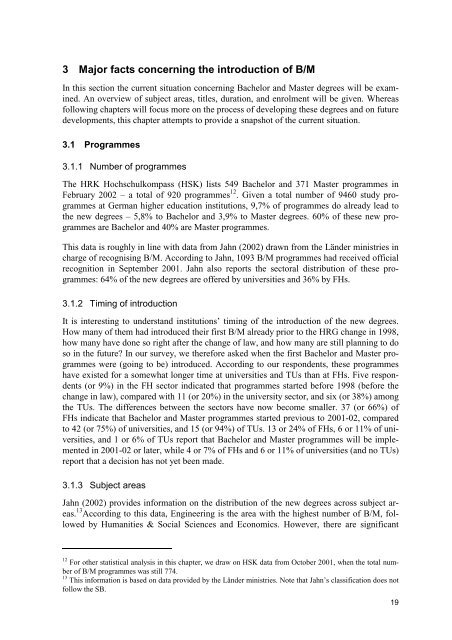and Master Programmes in German Higher Education Institutions
and Master Programmes in German Higher Education Institutions
and Master Programmes in German Higher Education Institutions
- No tags were found...
You also want an ePaper? Increase the reach of your titles
YUMPU automatically turns print PDFs into web optimized ePapers that Google loves.
3 Major facts concern<strong>in</strong>g the <strong>in</strong>troduction of B/MIn this section the current situation concern<strong>in</strong>g Bachelor <strong>and</strong> <strong>Master</strong> degrees will be exam<strong>in</strong>ed.An overview of subject areas, titles, duration, <strong>and</strong> enrolment will be given. Whereasfollow<strong>in</strong>g chapters will focus more on the process of develop<strong>in</strong>g these degrees <strong>and</strong> on futuredevelopments, this chapter attempts to provide a snapshot of the current situation.3.1 <strong>Programmes</strong>3.1.1 Number of programmesThe HRK Hochschulkompass (HSK) lists 549 Bachelor <strong>and</strong> 371 <strong>Master</strong> programmes <strong>in</strong>February 2002 – a total of 920 programmes 12 . Given a total number of 9460 study programmesat <strong>German</strong> higher education <strong>in</strong>stitutions, 9,7% of programmes do already lead tothe new degrees – 5,8% to Bachelor <strong>and</strong> 3,9% to <strong>Master</strong> degrees. 60% of these new programmesare Bachelor <strong>and</strong> 40% are <strong>Master</strong> programmes.This data is roughly <strong>in</strong> l<strong>in</strong>e with data from Jahn (2002) drawn from the Länder m<strong>in</strong>istries <strong>in</strong>charge of recognis<strong>in</strong>g B/M. Accord<strong>in</strong>g to Jahn, 1093 B/M programmes had received officialrecognition <strong>in</strong> September 2001. Jahn also reports the sectoral distribution of these programmes:64% of the new degrees are offered by universities <strong>and</strong> 36% by FHs.3.1.2 Tim<strong>in</strong>g of <strong>in</strong>troductionIt is <strong>in</strong>terest<strong>in</strong>g to underst<strong>and</strong> <strong>in</strong>stitutions’ tim<strong>in</strong>g of the <strong>in</strong>troduction of the new degrees.How many of them had <strong>in</strong>troduced their first B/M already prior to the HRG change <strong>in</strong> 1998,how many have done so right after the change of law, <strong>and</strong> how many are still plann<strong>in</strong>g to doso <strong>in</strong> the future? In our survey, we therefore asked when the first Bachelor <strong>and</strong> <strong>Master</strong> programmeswere (go<strong>in</strong>g to be) <strong>in</strong>troduced. Accord<strong>in</strong>g to our respondents, these programmeshave existed for a somewhat longer time at universities <strong>and</strong> TUs than at FHs. Five respondents(or 9%) <strong>in</strong> the FH sector <strong>in</strong>dicated that programmes started before 1998 (before thechange <strong>in</strong> law), compared with 11 (or 20%) <strong>in</strong> the university sector, <strong>and</strong> six (or 38%) amongthe TUs. The differences between the sectors have now become smaller. 37 (or 66%) ofFHs <strong>in</strong>dicate that Bachelor <strong>and</strong> <strong>Master</strong> programmes started previous to 2001-02, comparedto 42 (or 75%) of universities, <strong>and</strong> 15 (or 94%) of TUs. 13 or 24% of FHs, 6 or 11% of universities,<strong>and</strong> 1 or 6% of TUs report that Bachelor <strong>and</strong> <strong>Master</strong> programmes will be implemented<strong>in</strong> 2001-02 or later, while 4 or 7% of FHs <strong>and</strong> 6 or 11% of universities (<strong>and</strong> no TUs)report that a decision has not yet been made.3.1.3 Subject areasJahn (2002) provides <strong>in</strong>formation on the distribution of the new degrees across subject areas.13 Accord<strong>in</strong>g to this data, Eng<strong>in</strong>eer<strong>in</strong>g is the area with the highest number of B/M, followedby Humanities & Social Sciences <strong>and</strong> Economics. However, there are significant12 For other statistical analysis <strong>in</strong> this chapter, we draw on HSK data from October 2001, when the total numberof B/M programmes was still 774.13 This <strong>in</strong>formation is based on data provided by the Länder m<strong>in</strong>istries. Note that Jahn’s classification does notfollow the SB.19
















